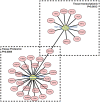Multiple Processes May Involve in the IgG4-RD Pathogenesis: An Integrative Study via Proteomic and Transcriptomic Analysis
- PMID: 32973752
- PMCID: PMC7468437
- DOI: 10.3389/fimmu.2020.01795
Multiple Processes May Involve in the IgG4-RD Pathogenesis: An Integrative Study via Proteomic and Transcriptomic Analysis
Abstract
Immunoglobulin G4-related disease (IgG4-RD) is a newly defined disease entity, while the exact pathogenesis is still not clear. Identifying the characters of IgG4-RD in proteomic and transcriptomic aspects will be critical to investigate the potential pathogenic mechanisms of IgG4-RD. We performed proteomic analysis realized with iTRAQ technique for serum samples from eight treatment-naive IgG4-RD patients and eight healthy volunteers, and tissue samples from two IgG4-RD patients and two non-IgG4-RD patients. Transcriptomic data (GSE40568 and GSE66465) was obtained from the GEO Dataset for validation. The weighted correlation network analysis (WGCNA) was applied to detect the gene modules correlated with IgG4-RD. KEGG pathway analysis was used to investigate pathways enriched in IgG4-RD samples. As a result, a total of 980 differentially expressed proteins (DEPs) in tissue and 94 DEPs in serum were identified between IgG4-RD and control groups. Three hundred fifty-four and two hundred forty-seven genes that most correlated with IgG4-RD were detected by WGCNA analysis in tissue and PBMC, respectively. We also found that DEPs in IgG4-RD samples were enriched in several immune-related activities including bacterial/viral infections and platelet activation as well as some immune related signaling pathways. In conclusion, we identified multiple processes/factors and several signaling pathways that may involve in the IgG4-RD pathogenesis, and found out some potential therapeutic targets for IgG4-RD.
Keywords: IgG4-RD pathogenesis; IgG4-related disease (IgG4-RD); WGCNA (Weighted Gene Co-expression Network Analyses); enrichment analysis; proteomic analysis.
Copyright © 2020 Cai, Chen, Lin, Ye, Zheng and Dong.
Figures







Similar articles
-
Proteomic characteristics of saliva in patients with different subgroups of IgG4-RD.Front Immunol. 2022 Nov 22;13:1026921. doi: 10.3389/fimmu.2022.1026921. eCollection 2022. Front Immunol. 2022. PMID: 36483554 Free PMC article.
-
The Platelet-Specific Gene Signature in the Immunoglobulin G4-Related Disease Transcriptome.Medicina (Kaunas). 2025 Jan 19;61(1):162. doi: 10.3390/medicina61010162. Medicina (Kaunas). 2025. PMID: 39859144 Free PMC article.
-
Proteomic analyses of plasma-derived exosomes in immunoglobulin (Ig) G4-related disease and their potential roles in B cell differentiation and tissue damage.J Autoimmun. 2021 Aug;122:102650. doi: 10.1016/j.jaut.2021.102650. Epub 2021 Jun 6. J Autoimmun. 2021. PMID: 34107438
-
Immune Dysregulation in IgG4-Related Disease.Front Immunol. 2021 Sep 1;12:738540. doi: 10.3389/fimmu.2021.738540. eCollection 2021. Front Immunol. 2021. PMID: 34539675 Free PMC article. Review.
-
Plasmacytoid Dendritic Cells as a New Therapeutic Target for Autoimmune Pancreatitis and IgG4-Related Disease.Front Immunol. 2021 Jul 23;12:713779. doi: 10.3389/fimmu.2021.713779. eCollection 2021. Front Immunol. 2021. PMID: 34367181 Free PMC article. Review.
Cited by
-
The spectrum of B cells in the pathogenesis, diagnosis and therapeutic applications of immunoglobulin G4-related disease.Clin Transl Immunology. 2023 Nov 28;12(12):e1477. doi: 10.1002/cti2.1477. eCollection 2023. Clin Transl Immunology. 2023. PMID: 38034079 Free PMC article. Review.
-
Involvement of sphingosine-1-phosphate receptor 1 in pain insensitivity in a BTBR mouse model of autism spectrum disorder.BMC Med. 2024 Nov 4;22(1):504. doi: 10.1186/s12916-024-03722-3. BMC Med. 2024. PMID: 39497100 Free PMC article.
-
Omics in IgG4-related disease.Chin Med J (Engl). 2025 Jul 20;138(14):1665-1675. doi: 10.1097/CM9.0000000000003320. Epub 2024 Oct 25. Chin Med J (Engl). 2025. PMID: 39450944 Free PMC article. Review.
-
Proteomic characteristics of saliva in patients with different subgroups of IgG4-RD.Front Immunol. 2022 Nov 22;13:1026921. doi: 10.3389/fimmu.2022.1026921. eCollection 2022. Front Immunol. 2022. PMID: 36483554 Free PMC article.
-
Perception of recurrence risk in patients with IgG4-related disease: a descriptive phenomenological study.Rheumatol Adv Pract. 2024 Dec 4;9(1):rkae148. doi: 10.1093/rap/rkae148. eCollection 2025. Rheumatol Adv Pract. 2024. PMID: 39717021 Free PMC article.
References
Publication types
MeSH terms
Substances
LinkOut - more resources
Full Text Sources
Research Materials
Miscellaneous

